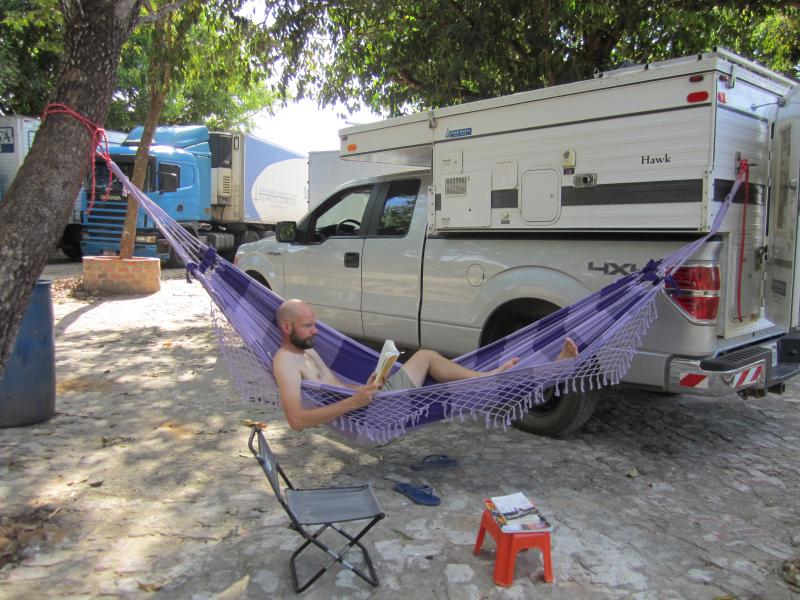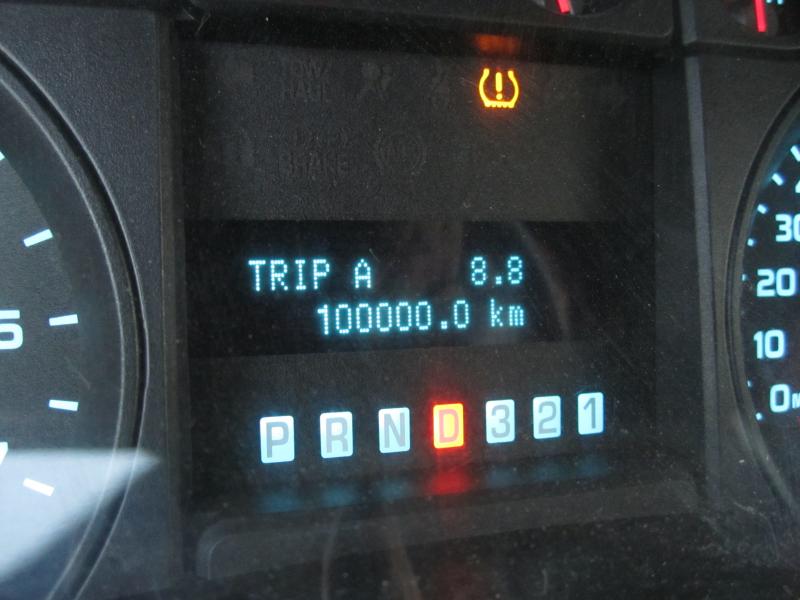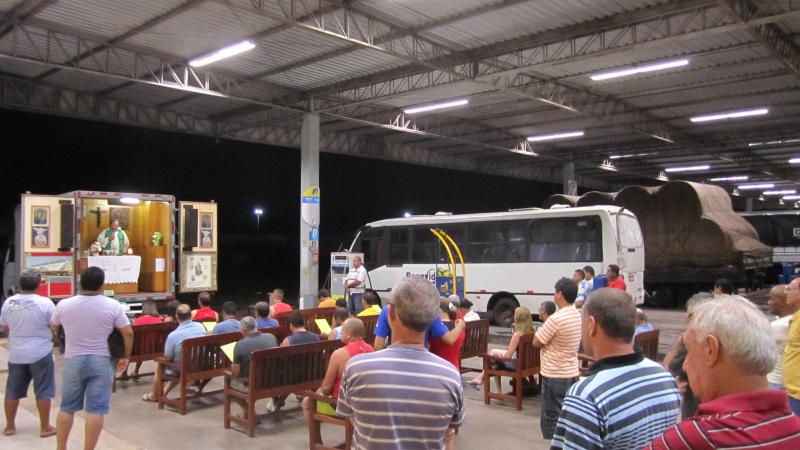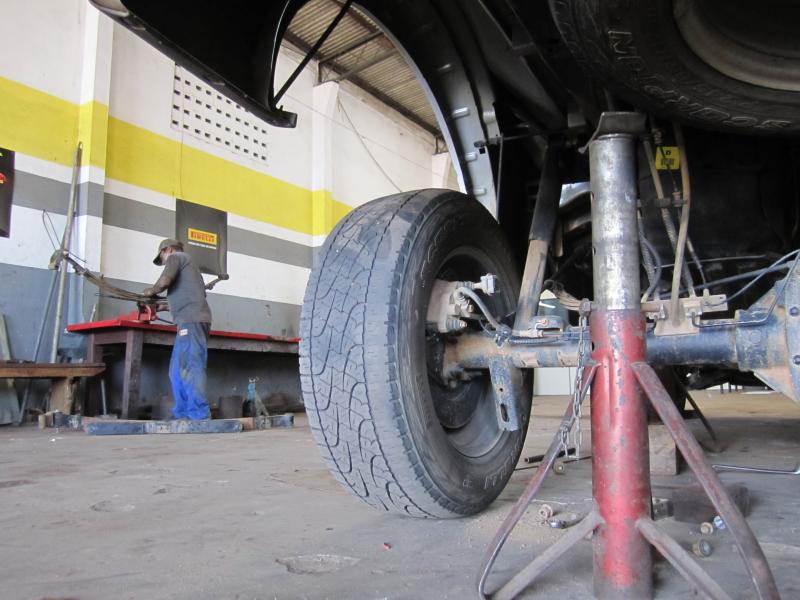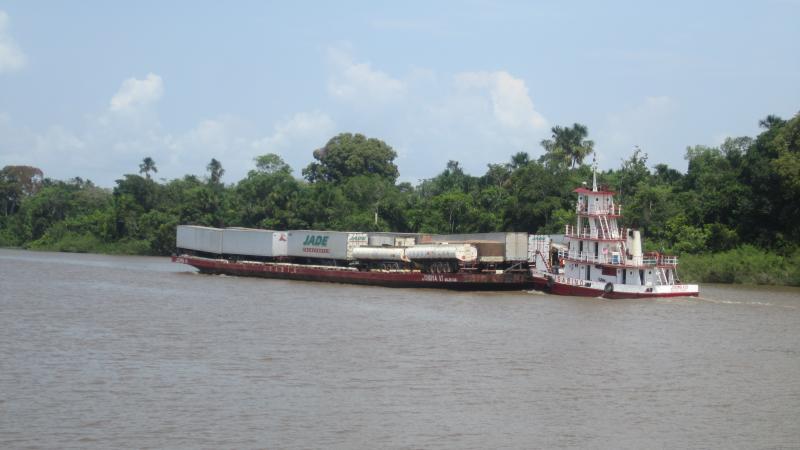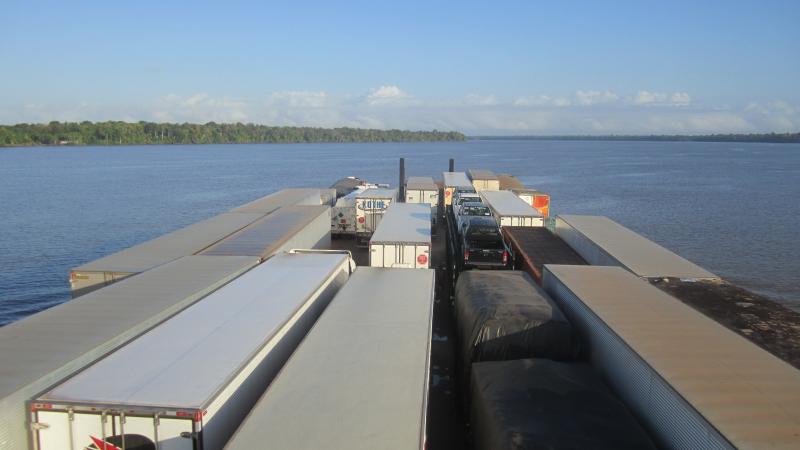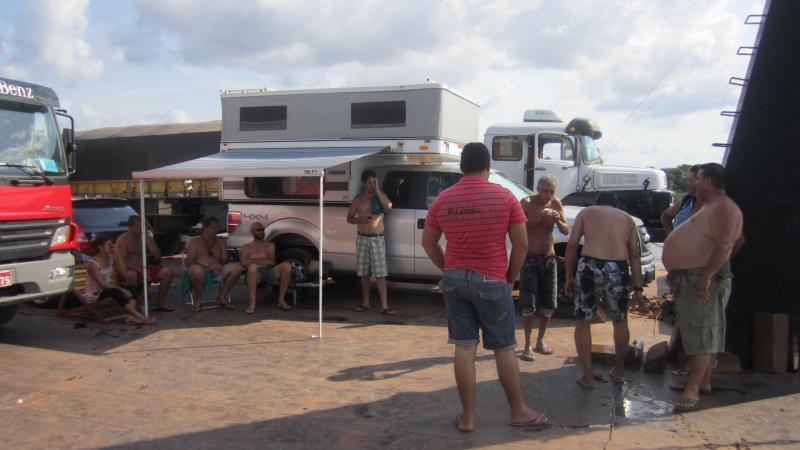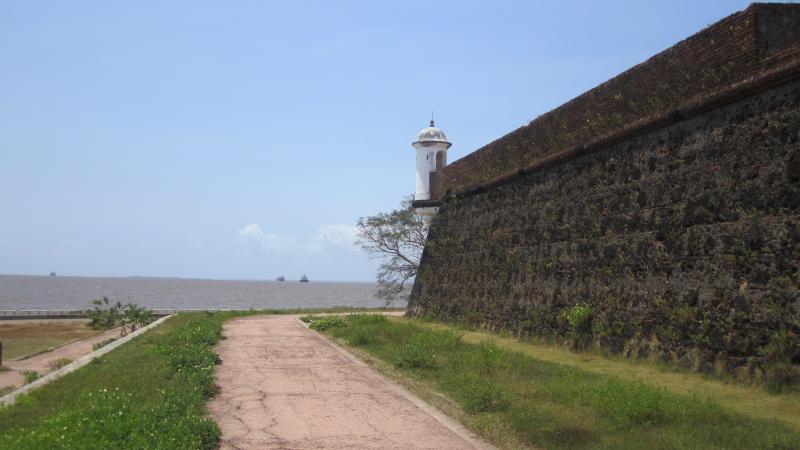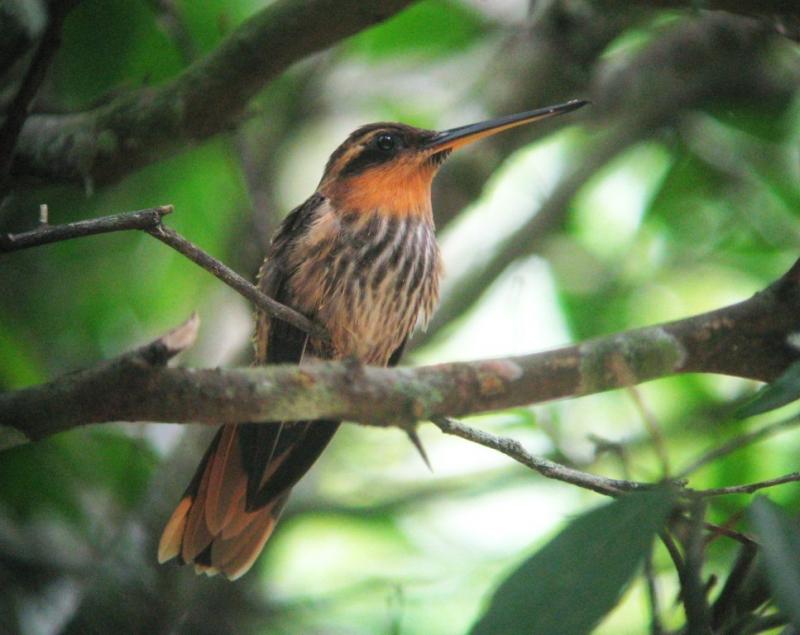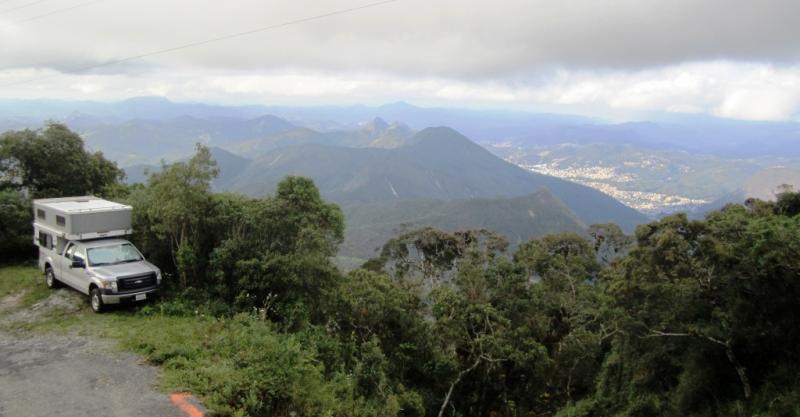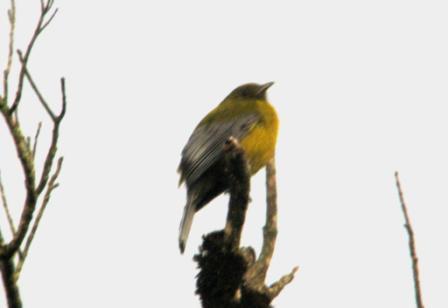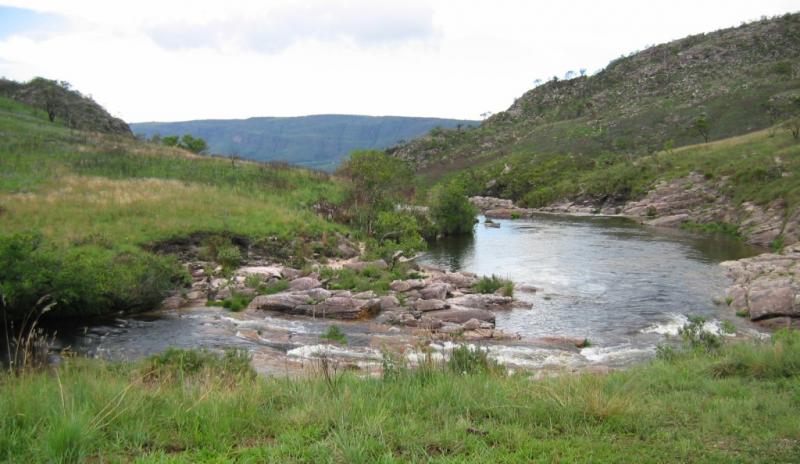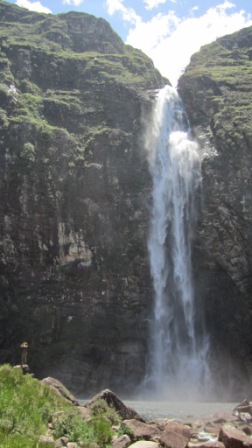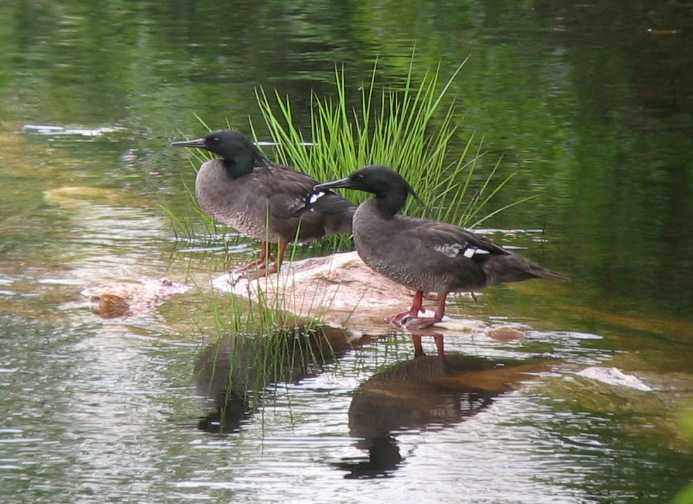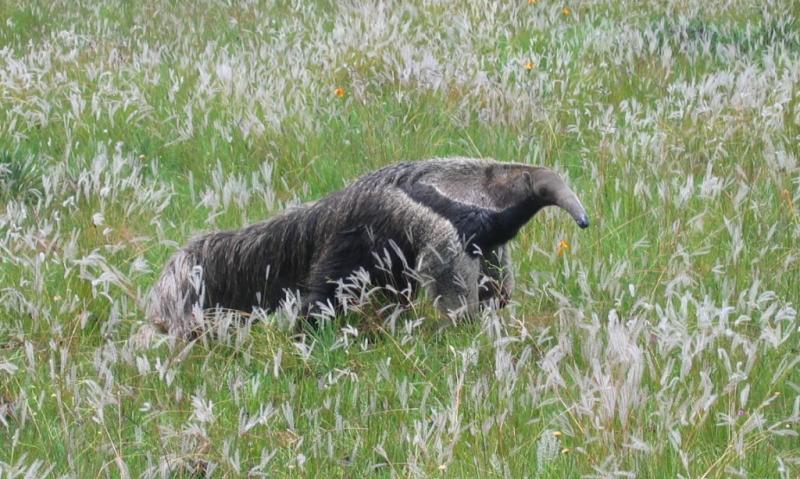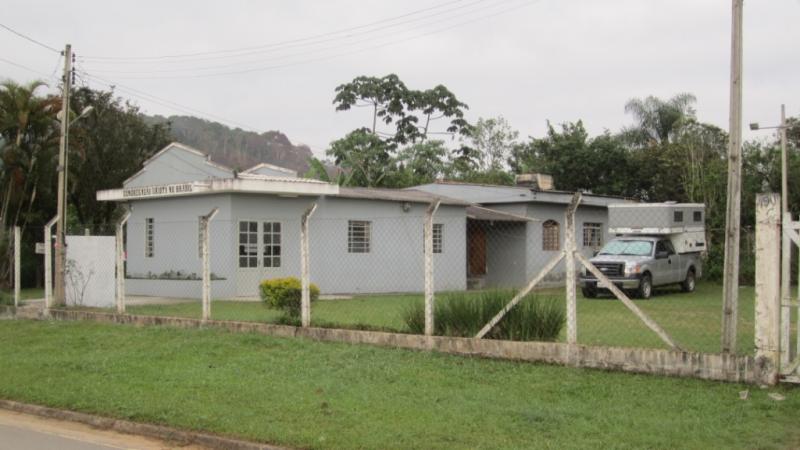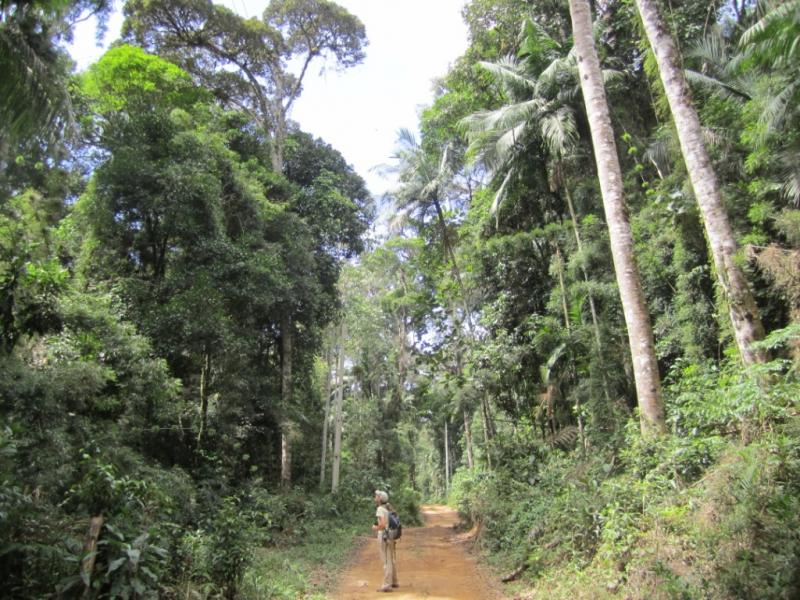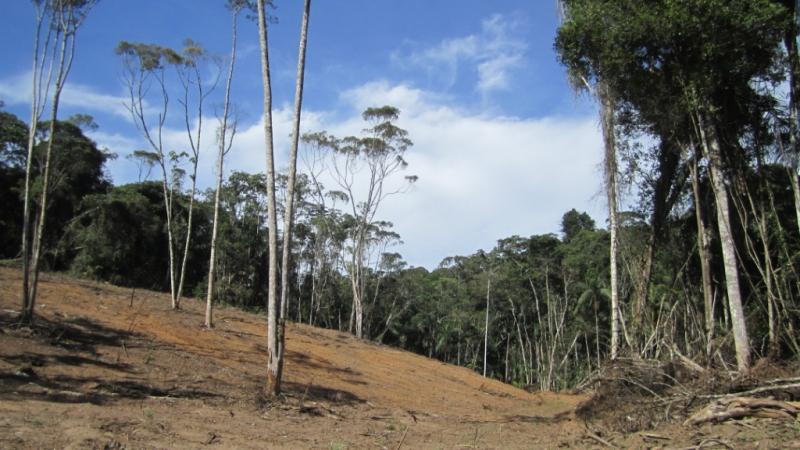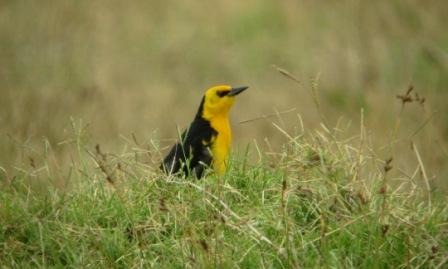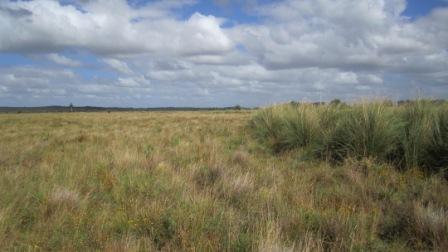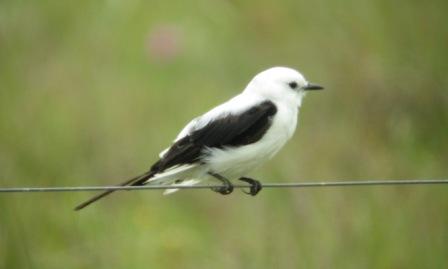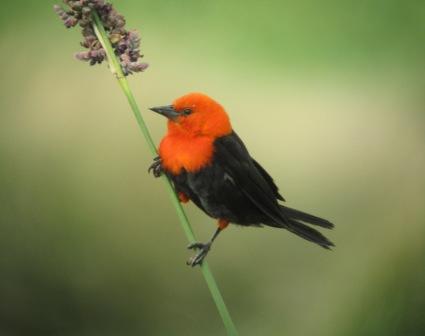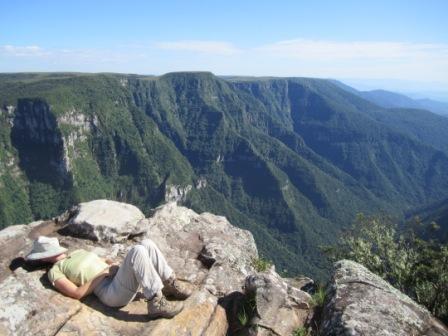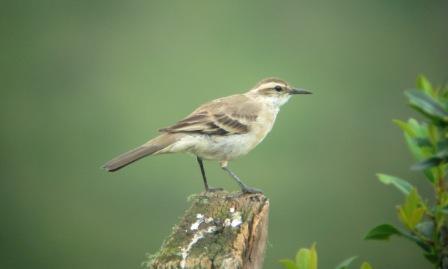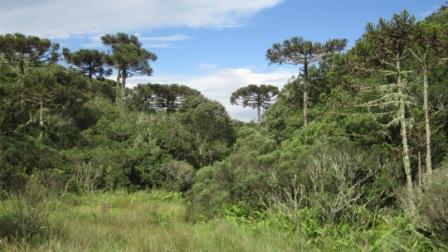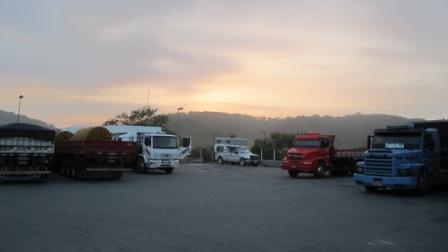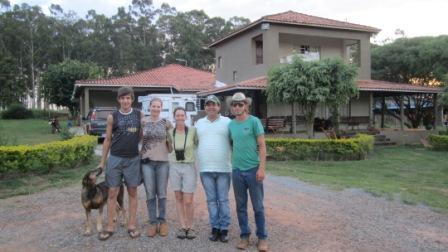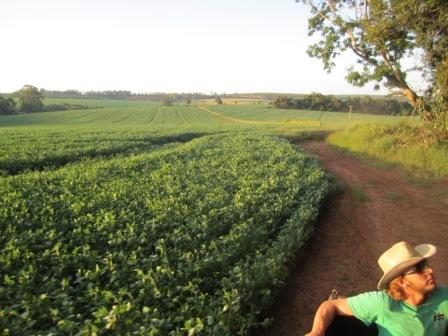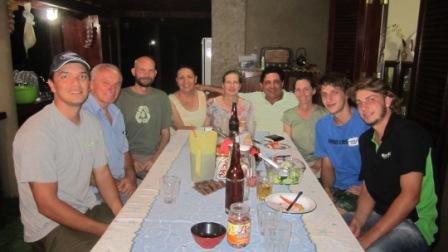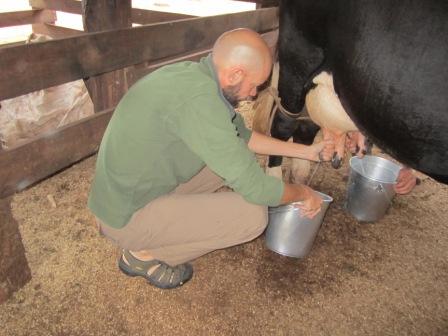calyptura.com
Jon and Anne's birding travels
Blog
"Do Oiapoque au Chui"
Posted 19 September 2012
Our title is a well-known catchall Brasilian phrase, “from Oiapoque to Chui”, similar to the British “from Land’s End to John O’Groats”. Of course we didn’t know this when we entered from Uruguay at Chui, the southernmost town of Brazil, back in January. We only heard of the expression as we neared Oiapoque, the northernmost coastal town in the country in extreme northern Amapa state, which ended up being our point of departure to French Guiana at the end of August. So we both literally and metaphorically explored Brazil from top to bottom, although even in 203 days in Brazil, we still only felt like we explored about a third of this massive and fascinating country.
Due to a scare with the health of Anne’s mum we rushed through much of Para and Amapa states so that we could get close to the easier departure airports of the Guianas (thankfully after a week or so she recovered quickly and no flight back to the US was ultimately necessary). Nevertheless, we had plenty of great birding and travel experiences in our last month in Brazil, although for some reason we got very few bird photos, so this update focuses on other topics.
Jon fully embracing the hammock-and-flip-flops culture which is rightly stereotypical of Brasil. Most truckers in the warmer north of Brasil stop for a siesta in the early afternoon hours, many stringing up their hammocks to the nearest tree, or even underneath their trailer when that is the only shade around. We often chose to drive at this time of day as the roads were virtually deserted, but not on this particular afternoon.
Trocky the wonder-truck reached exactly 100,000 kilometers early one morning on our way to a birding site at Caxias in Maranhao state. Five hundred metres later we finally found Blue Finch. Nearly all of these kms have been within Latin America, as the truck only had just over 2,000 kilometers when we crossed into Mexico back in April 2010. Just over a quarter of the kilometers we’ve driven so far have been in Brazil alone!
A few of the Brazilian postos (gas stations) we’ve stopped at have had small chapels; twice we have even seen a chapel next to the restrooms in a city shopping mall. So we were not too surprised to see a very nice chapel in the parking lot of a large posto we stayed at near Belem and posters advertising mass to be held that night. But we were surprised to discover that the mass would not be in the onsite chapel, but out of the back of this mobile chapel parked right next to the fuel pumps (you can see a bus and two trucks filling at the pumps just to the right)! The small “chapel truck” pulled right up in one of the fuel lanes, which was promptly coned-off, and all the benches from the nearby seating area were pulled out into the lane. Despite his PA system, it was difficult to hear the priest above all the vehicle noise, but he still attracted a pretty good crowd from the overnighting truckers.
With the truck coming of age, and knowing that we would have some challenging dirt roads ahead in Amapa and the Guianas, it was time to get the rear leaf springs reshaped for the second (and probably final) time. The springs slowly flatten out over time with the constant weight of the camper, and getting them reshaped about once a year has proven to be a remarkably simple and economic remedy. We knew the big port city of Belem at the southern mouth of the Amazon would give us plenty of options to get this job done, but when the first place we asked (at 2pm) said they could do it that same afternoon while we sat in their air-conditioned waiting room surfing the internet, we were delighted. They did an excellent job. Even better, and for reasons that made no sense to us in Brazil’s economy, it only cost R100 ($50), despite three solid hours of manual labour in the sweltering heat of a tropical garage (we were sure to give a very healthy tip to the primary mechanic, shown contemplating our removed leaf springs, in the photo).
At the end of August we reached Belem, the capital of Para state, on the southern mouth of the Amazon River delta and our departure point for crossing the World’s greatest river. Thanks to good information from other travelers we were able to make arrangements for the voyage relatively easily. We travelled on a large flat barge pushed by a tug, like the one pictured above, that we passed en route. These barges are primarily used to transport cargo trucks and trailers up, down, and across the river. The one we were on had about 20 large trucks and several smaller trucks and vans. We were able to get a prime spot at the front thanks to Jon’s friendly conversation and small “tip” to the man in charge of loading (the tip was a recommendation of a truck driver Jon chatted to a couple of nights earlier at a Belem area petrol station). You can just make out the top of the camper in the captains-eye-view picture below at the far end, left of the ramp.
Even at a fairly consistent speed in a large vessel, it takes 40 hours to cross the Amazon delta. We spent two nights and one full day on the barge, traveling through channels of varying size, from only a few hundred meters across to over a mile. Jon (and his rapidly improving Portuguese) made friends with many of the truck drivers, who congregated under our awning in the afternoon, as it provided the only shade available. It was a very social atmosphere, with lots of joking around and a fair bit of drinking, despite the supposed prohibition of alcohol. Several times during the day, drivers transporting perishable goods brought out some of their cargo to share, including oranges, plums, guavas, and yoghurt. We were very appreciative of their generosity but also dismayed to learn some of the fruit had come all the way from Spain (via Sao Paulo)!
When it came time to land in Amapa, there was another barge at the main concrete dock and we had to use the adjacent riverbank instead. On the first attempt, we sort of crashed into the bank, where there was debris blocking the exit (above). After some careful maneuvering and a lot of hard work with the lines, the crew was able to get us over to a clear area. The crash landing had pushed a lot of dirt from the bank up onto the loading ramp. Fortunately the intrepid gringos had a small shovel that we loaned a crew member to help clear the ramp enough for everyone to offload. Below, you can see Jon’s trucker friend Luis Carlos telling the crewman he needs to give us back our shovel as Jon drives off the barge!
Old Brasil meets new. Built by the Portuguese in the late 18th century in a largely successful attempt to protect the northern mouth of the Amazon from the ships of the British, French, and Dutch, the solid construction of the Fortaleza Sao Jose de Macapa has withstood the ravages of an extreme tropical climate. In the distance, huge ships sit offshore. Of the seven we counted, six were for transporting ore. We had learned of a huge iron ore mine in Amapa from Luiz Carlos, who delivers a cargo of phosphate (for dynamite production) every month from Minas Gerais.
Back to Brasil: from the Pantanal to the World's rarest tapaculos
Posted 25 July 2012
We returned to Brazil from Paraguay on 12th June and have been moving almost continuously ever since, visiting many different sites and habitats from the wetlands of the Pantanal to the vast desert-like caatinga of the inland northeast. Time permits us to mention only a small sample of our experiences over the last month-and-a-half.
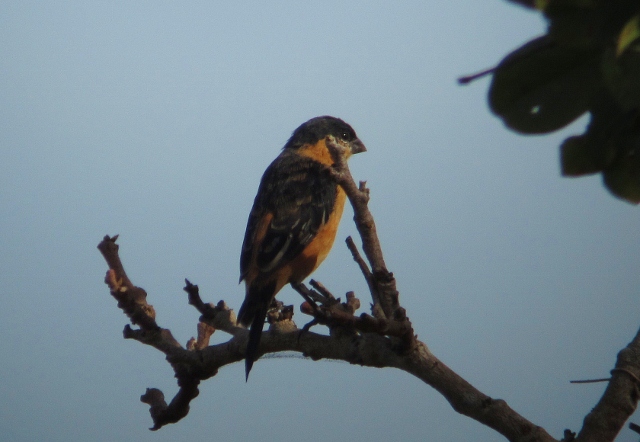
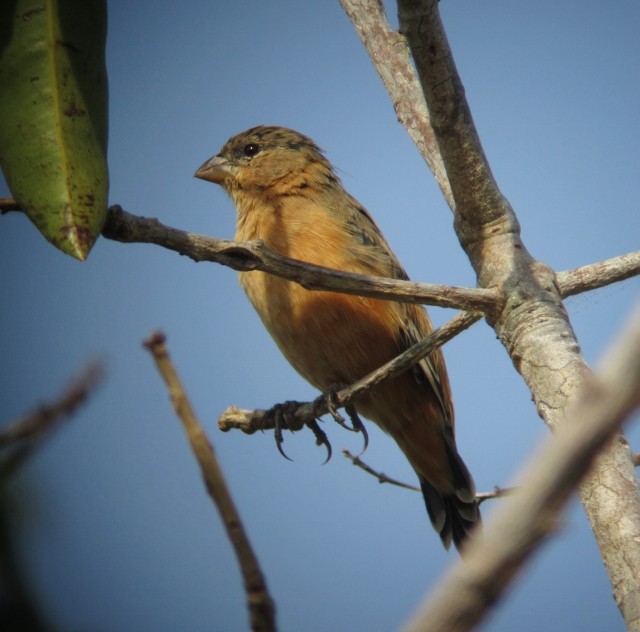
Black-and-tawny Seedeaters, 15th June 2012, Vila Bela de Santissima Trinidade, Mato Grosso. An adult male (left) and immature male (right), the latter plumage may not have been previously described and/or photographed. We made the largest diversion of our entire journey to try to find this species. Perhaps only seen by a couple of dozen birdwatchers ever, this seedeater is (obviously) very poorly known, and is thought to occur only in a couple of locations hundreds of kilometres west of the Pantanal in western Brasil, and in adjacent Bolivia.
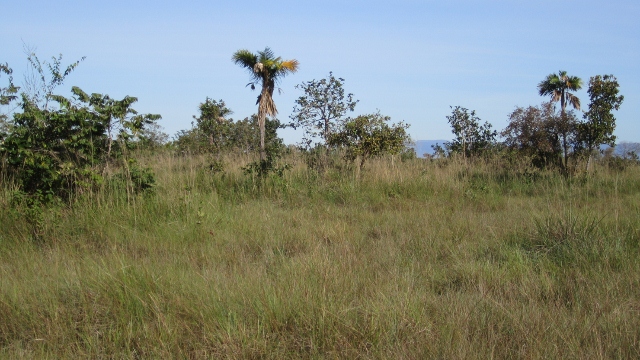
The scrubby and marshy palm savannah habitat of Black-and-tawny Seedeater, not far from the wonderfully named village of Vila Bela de Santissima Trinidade in extreme western Mato Grosso state.
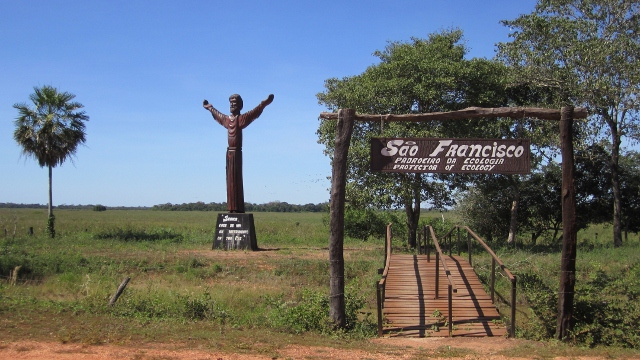
We had both long anticipated visiting the Brazilian Pantanal and we were warmly welcomed by this giant carving of Saint Francis near the beginning of the Transpantaneira. This dirt road was originally intended to cross the entire Pantanal but upon reaching a major river about a third of the way in, the government wisely thought better of the plan and ended the road there, which is where we also turned around. Nevertheless, the track gives excellent access to this huge marshland and its abundant birds and other wildlife.
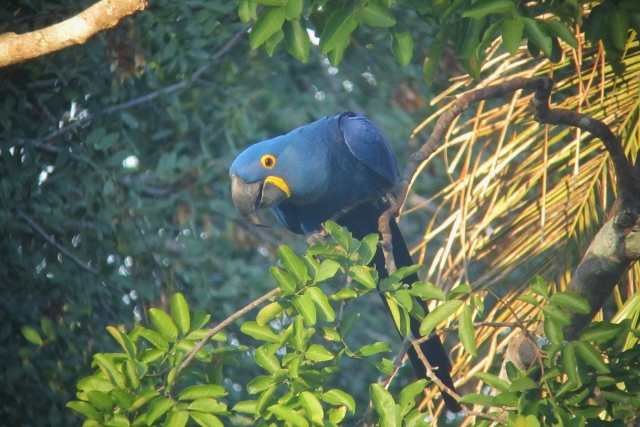
The World's biggest parrot, Hyacinth Macaw, is rather common in the Pantanal, but regrettably now almost extirpated from the rest of its former distribution (mainly due to trapping for the cagebird trade). They are very big, very blue, and very loud.
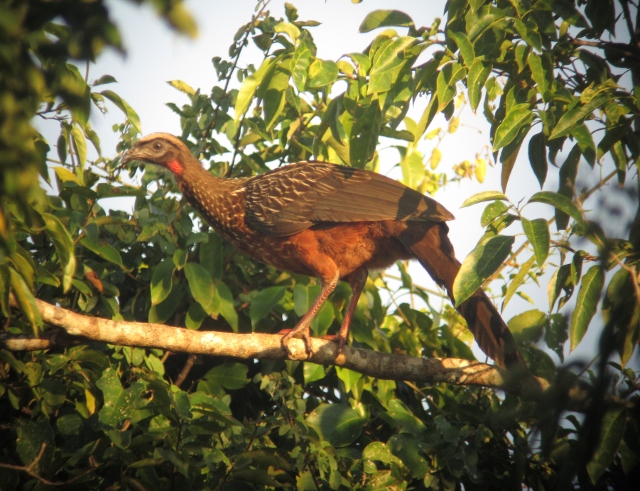
Chestnut-bellied Guan, 17th June 2012. Although many folks visit the Pantanal for the waterbird spectacle (which was impressive), we were even more interested in the localised species that are found only in and near the area, of which the guan is a good example.
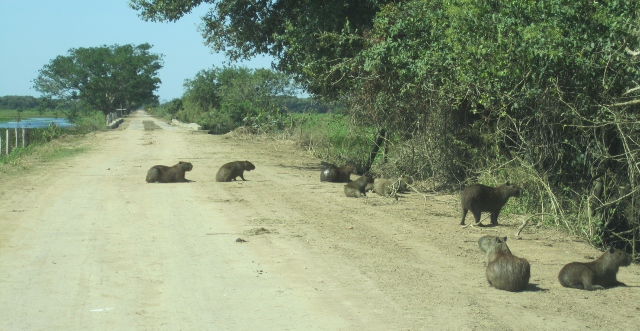
Hazards of driving the Transpantaneira include abundant capybaras idling away the warm afternoons in the middle of the track . . . .
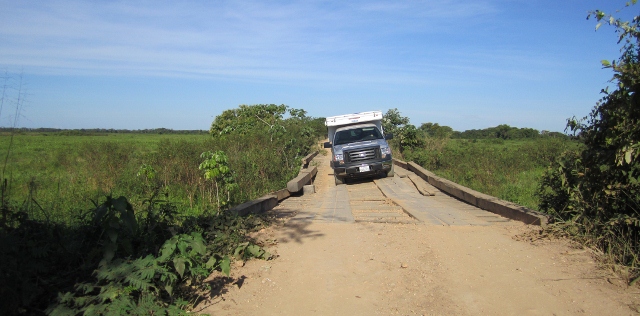
. . . .and about 120 wooden bridges, of which some are in, let's say, less-than-perfect condition.
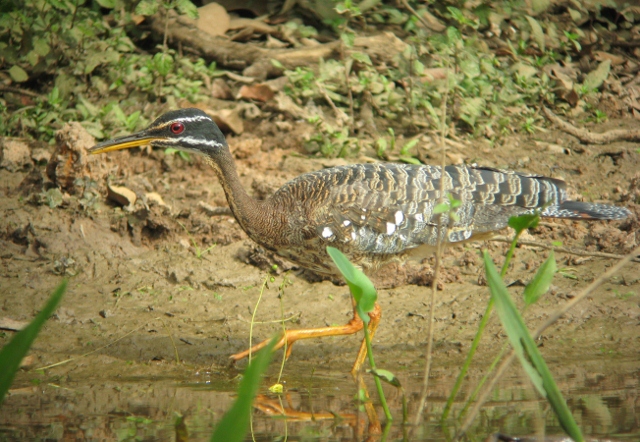
No visit to the Pantanal is complete without seeing the truly bizarre Sunbittern. One of the World's strangest and most stunningly plumaged birds, it has a wide Latin American distribution, but is generally very hard to see everywhere except in the Pantanal. It is so unusual that it is one of only a handful of birds to be placed in a family all on its own. It is even more spectacular in flight, when each open wing shows a giant black and rufous "eye" pattern, as if it were a huge moth.
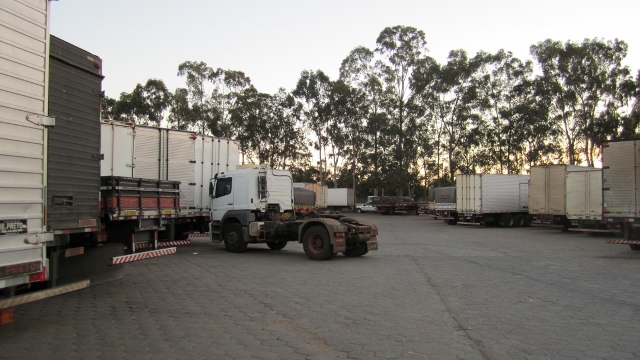
Can you spot us? (We are just visible right of centre at the very back.) We arrived at the booming industrial city of Goiania (in Goias state) at sunset, desperate to find a secure place to park. We turned the right way and found one of the World's largest truck stops! We were the only non-lorry in this 200+ truck stop which was a small enclosed town unto itself, with shops, restaurants, bars, a laundry, TV watching area, and its own chapel. We made great use of the facilities for getting our long-overdue laundry done, having our first showers in days, and making the most of their great wifi (oddly a rarity in Brasil). Jon even managed to get the staff to put the England-Italy European Championship match on the TV.
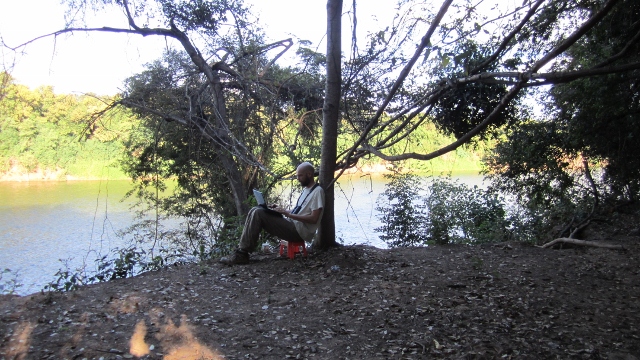
Jon doing some writing on a warm afternoon on the bank of the Rio das Velhas, near Pirapora, Minas Gerais. We visited this area in the Sao Francisco river valley primarily to find Minas Gerais Tyrannulet, a small flycatcher restricted to only a few known sites in central Brazil, plus the equally localised Bahia Nighthawk. Our rapidly expanding Portuguese stretched to asking the local farmer for permission to camp in his nearby field, which proved to be one of the most peaceful campsites of the journey.
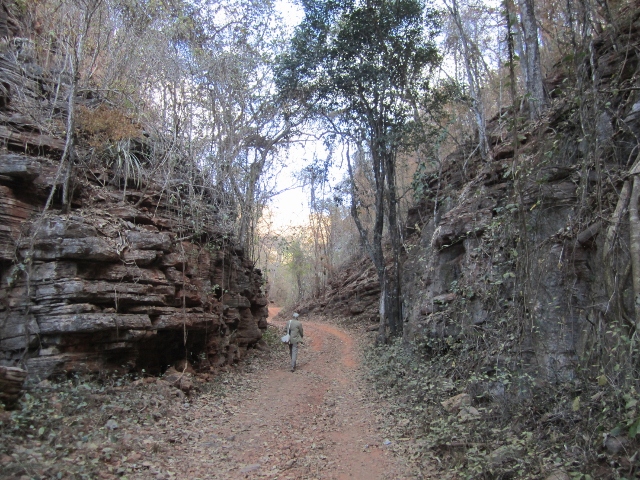
Just west of the rio Sao Francisco is the large Parque Nacional Cavernas do Peruacu, a beautiful rocky landscape of dry scrub and forest (and apparently spectacular caves). We drove far out of our way to get to this park and were more than slightly dismayed when we were told by a park guard at the headquarters that the park is for research only and is closed to tourists. Fortunately, we were able to get him to allow us access along the narrow dirt road that traverses the park, which proved to be perfect for birding and seeing certain rock-loving mammals. We were somewhat surprised to find scattered small farms and even a small village along the road - yet another example of how the Brazilian concept of a national park isn't quite what we’re used to.
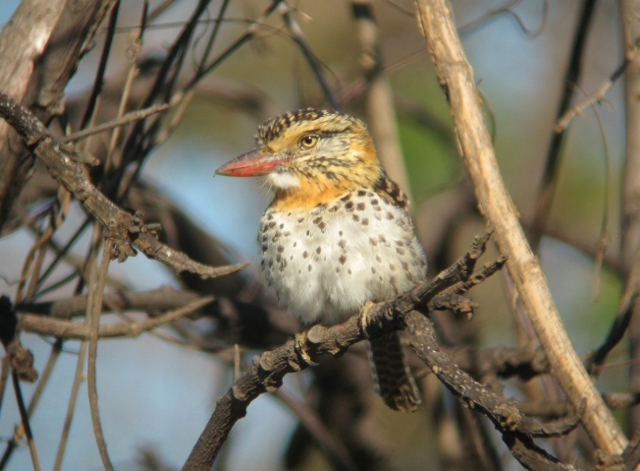
Caatinga Puffbird, 2nd July 2012, Januaria, Minas Gerais, Brazil. This beautiful bird is one of many restricted to the dry inland cerrado and caatinga habitats of Brazil.
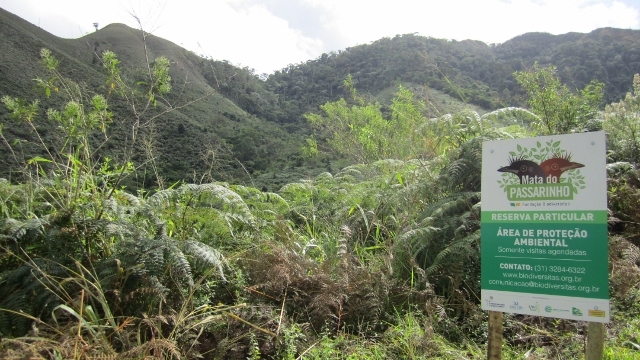
Regrettably we have become used to seeing extremely rare animals, but our time at Mata do Passarinho was perhaps the most humbling (and frankly depressing) of all such experiences. We were here to look for Stresemann's Bristlefront, a member of the tapaculo family, and seemingly one of the rarest birds in the world.
This species was rediscovered in coastal Bahia in 1995, fifty years since its last previous sighting. Only a single male was known from that site and it soon disappeared. The species was then found at Mata do Passarinho shortly thereafter and emergency efforts were made to purchase some of the very small amount of forest remaining and set up a reserve. Sadly, extensive survey of the reserve and adjacent unprotected forest in 2010 identified only five individuals, one male and four females. Hopefully there are more of these lovely birds out there somewhere else, but it is certainly a species under threat of imminent extinction, regardless. In the photo, you can just see the patch of forest in the tiny valley near the top of the ridge (above and left of the sign) in which all of the known individuals occur. This is where we got great views (and sound recordings) of the only known male.
We were just about able to get to the area after heavy rain, thanks to the superb performance of our truck (even a brief need for low-ratio 4WD at the end), but that is another story….
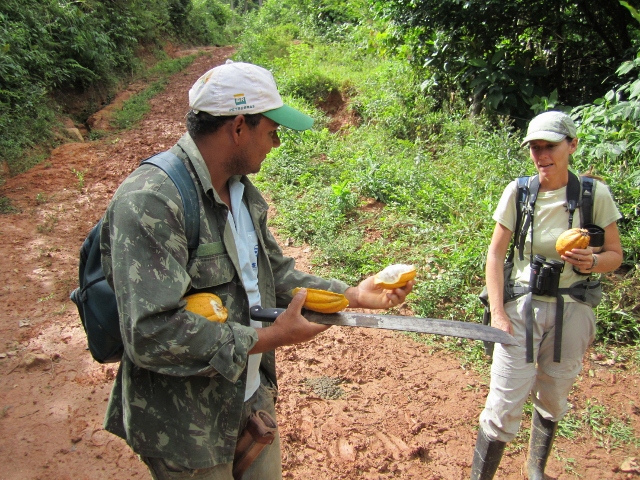
On our way back down the hill, our park guard companion Bil kindly obtained some cacao fruits from one of the small farms. Much of the forest loss in the area has been due to planting of cacao, the source of chocolate. As we certainly eat our fair share of chocolate, we were dismayed by the connection to the plight of the bristlefront. Nonetheless, we enjoyed Bil's demonstration of how to open the fruit with a machete and suck the seeds to enjoy the very tasty fruity pulp that surrounds them. The seeds can then be dried and used to make chocolate.
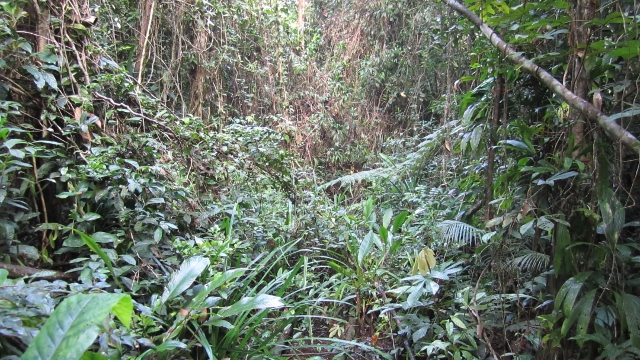
Described by one of our (very recent) bird field guides as "essentially unknown in life" and by another as "possibly extinct", fortunately the Bahia Tapaculo has been found at a few sites in southern coastal Bahia in the last couple of years. We were very fortunate to get excellent views and recordings of multiple individuals along this tiny, heavily-forested stream at a small private reserve called Agua Boa.
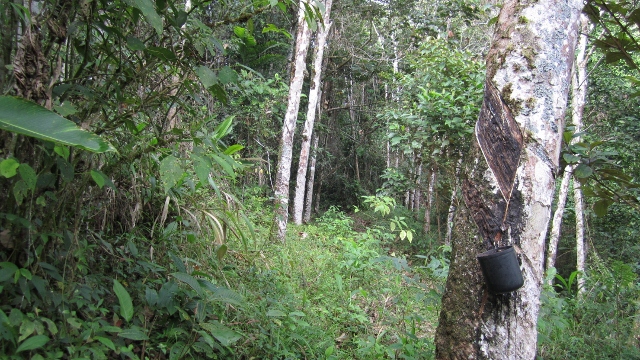
We have visited hundreds of parks and reserves on these travels but some of the most impressive have been the small private reserves spear-headed by individuals. Agua Boa, the site where we saw Bahia Tapaculo, is such a reserve. Norberto Hess inherited the property from his German immigrant father and has worked hard to perpetuate his father's vision for the land. Part of the property is set aside as an official reserve and other areas show how agricultural uses can be combined with preservation of the habitat quality. These actively tapped rubber trees are situated well within the forest (rather than as a monoculture plantation), only a few hundred metres from Bahia Tapaculo habitat.
Farewell Southern Brazil
Posted 21st May 2012
With Anne safely returned from San Diego at the beginning of May, we went back down the Brazilian coast to visit (and revisit) a few areas before heading west into new territory: the famous Iguazu Falls and then Misiones province of far northeastern Argentina. Our first stop was Ilha Comprida ("Long Island"), a lovely coastal island south of Sao Paulo. The main target here was the very range-restricted Red-tailed Parrot, and we were not disappointed, with great views of many moving to and from roost sites.
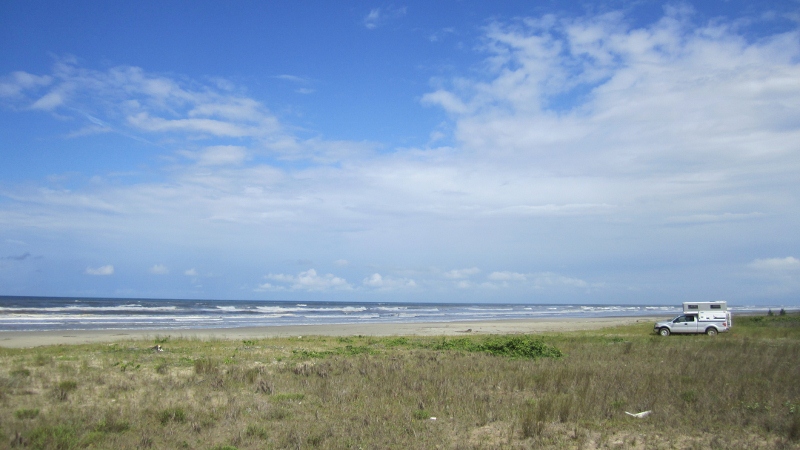
Our lovely beachside campsite at Ilha Comprida, with the sea almost literally lapping at our tyres.
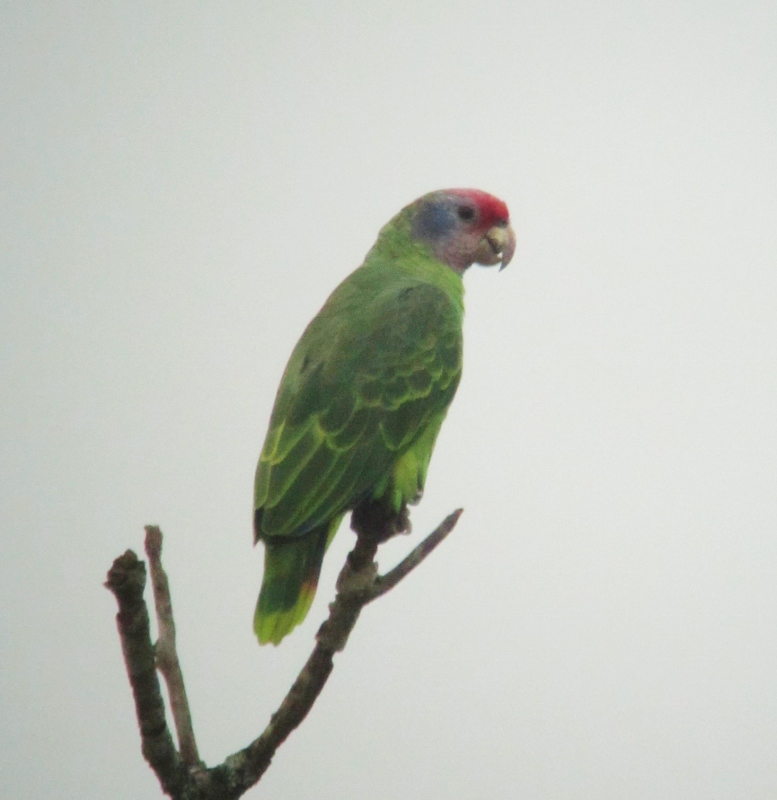
But we were not here for the sun and surf, but for the Red-tailed Parrots to be found in the stunted dune scrub and forest ("restinga") behind the beaches. This one is doing its best to avoid showing the red (which is much more visible on the underside of the tail).
After the Ilha we retraced our steps to two of our favorite places in Brazil: Parque Estadual Carlos Botelho, and Fazenda Santo Antonio (the home of our friends the Almeida family, featured earlier in our blog), both in southern Sao Paulo state. Although much-loved places don't always live up to expectations on a return visit, this was certainly not the case with these two.
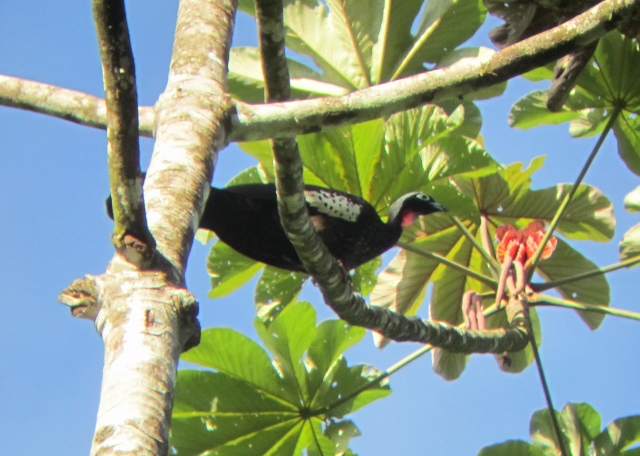
Black-fronted Piping Guan, Parque Estadual Carlos Botelho, Sao Paulo, 8th May 2012. We were very fortunate to again find this very hard species (three of them this time) along the road that traverses the park.
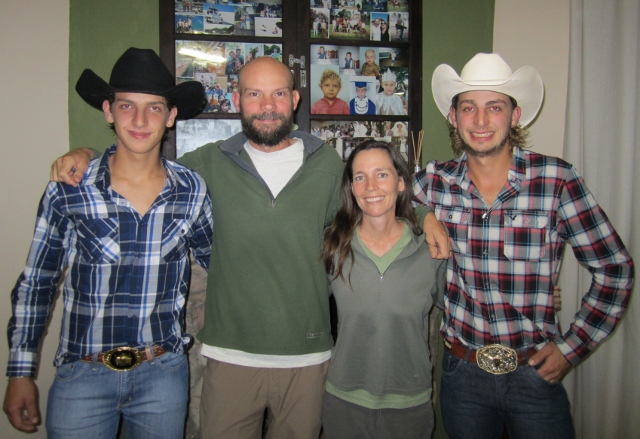
Helinho (right) and Antonio (left, the Almeida's sons) in full Brasilian cowboy gear for opening night of their hometown annual rodeo.
From Fazenda Santo Antonio we made our way back to Parana state and the Curitiba area to try again for Marsh Tapaculo. This time Jon was successful and was able to get good views and reasonable recordings of this, one of the toughest of the tapaculos to actually see. Then we visited a new friend Jon had met at REGUA, Luciano Breves, who lives in the small town of Morretes, between Curitiba and the coast. Our main reason for the visit was to spend time in his remarkable bird-filled urban garden, and especially a chance to see Black-backed Tanager coming into the fruit feeders Luciano has there. After hours of observation, Jon got a good, if brief, look at a stunning male.
But it was equally interesting to see Luciano's set-up and learn more about his live-cam feeding stations. He is an expert bird videographer and, via the internet, truly dedicated to bringing beautiful Brazilian birds into the homes of folks around the World that arent lucky enough to have them in their backyards. He especially hopes to encourage young Brazilians see the wonderful birdlife of their own country and hopefully therefore develop a desire to conserve it. See his great work at www.ornithos.com.br
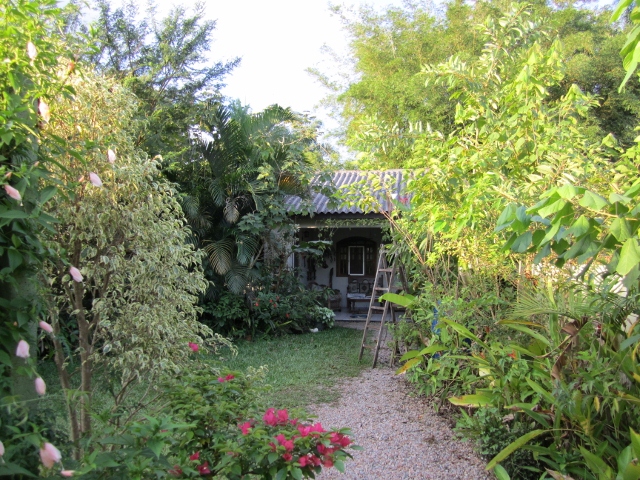
Luciano's superb garden, with one of his world famous bird tables just right of the step ladder. The ladder holds up a pole with a light, so the live cam can even run all night, giving viewers an opportunity to see nocturnal mammals from time to time, including fruit bats in the austral summer. Our truck was just able to squeeze through his gate and into the yard, where Luciano very kindly let us camp for two nights, so we had an even better view than from the live cams!
Finally it was time for us to do some rare "normal tourist" activity and visit Iguazu Falls. Often argued to be the World's greatest falls, they are located on the Iguazu River, which forms the border between Brazil and Argentina, with Paraguay barely a stones throw away. We visited the falls from the Brazilian side, where you can get an excellent overall view, and the morning light shows the falls at their best. Although water levels were relatively low, it was a spectacular sight and well worth the visit. Even here the preserved forest provided us with some good birding opportunities. Then after a superb four months and three days, it was farewell to southern Brasil.
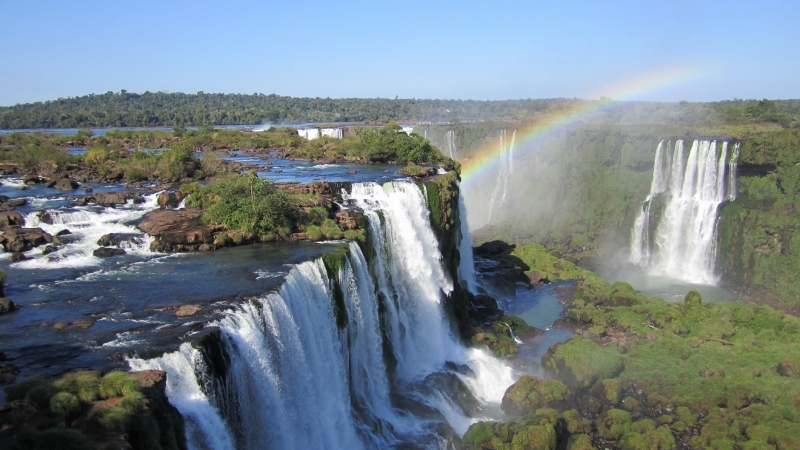
The incomparable Cataratas do Iguazu, Parana, Brazil. Below, a closer view of the Garganta do Diablo.
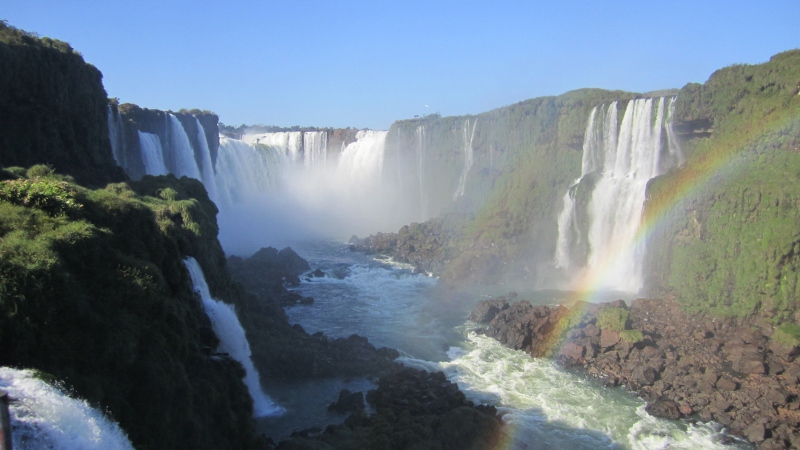
April 2012: REGUA
Posted 30th April 2012
As those who follow us on Twitter will know, Anne went to California for much of April for family reasons, leaving Jon to tough it out solo in deepest, darkest south-east Brazil. With plenty of birding still to be done, and more than years worth of sound recordings to edit and organise, he based himself for the month at REGUA, the Reserva Ecologica de Guapiau, not far from Teresopolis. This superb reserve is tucked at the base of the Serra dos Orgoas, the imposing mountain range just an hour or so north of Rio de Janeiro. Shortly after college, Jon briefly worked with a UK-based organisation that years later was instrumental in setting up REGUA, and thanks in part to this contact, he was able to arrange to stay with our truck-camper at the reserve in return for a modestdonation and some volunteer help accompanying their bird guides in the field.
We have firsthand experience of hundreds of conservation projects around the World, especially in Latin America, and given our professional backgrounds we tend to look at them all with a critical eye. REGUA is among the most impressive of all the projects we have encountered. It combines high quality existing forest with very active reforestation, plus some restored wetlands. It provides great support to a constant procession of Brazilian and international researchers, has an excellent volunteer program, and seems to be well integrated into the local community employing over 20 locals in many capacities. A high class bird lodge was built on the reserve a few years ago which provides an excellent base for visitors, complete with tour program and superb local guides, and profits from this environmental tourism now cover about 50% of the entire reserve budget. Not surprisingly, it is considered something of a model for sustainable conservation projects and restoration of tropical forest. REGUAs location is especially important in the Mata Atlantica, the Brazilian Atlantic forest, one of the Worlds most endangered ecosystems, where only some 5-10% of the original forest cover remains (hence all the rare birds and other wildlife). If you are interested in reading more about the reserve, or even visiting or volunteering, take a look at their website, http://www.regua.co.uk/
Despite the time we had previously spent in southern Brazil, there were still a few birds to find. By fortuitous coincidence, the REGUA area happened to be a particularly good place to try for most of them. Indeed, Jon ended up seeing more of his hoped-for species than expected in the month. Highlights included Blue-bellied Parrot, Grey-winged Cotinga, Russet-winged Spadebill, many great observations of Elegant Mourner (also known as Shrike-like Cotinga), Mantled Hawk, Buff-bellied Puffbird, Half-collared Sparrow, and Giant Snipe, among others.
Saw-billed Hermit, Casa Pesquisa, 25th April 2012. Not rare but a lovely hummingbird nonetheless, and endemic to the Mata Atlantica. For those of you in the western US, it is at least twice the size of Annas Hummingbird, and obviously with an unusual colour scheme for a hummer. This individual used to buzz me in my hammock at the Casa Pesquisa (research house) in the forest at REGUA.
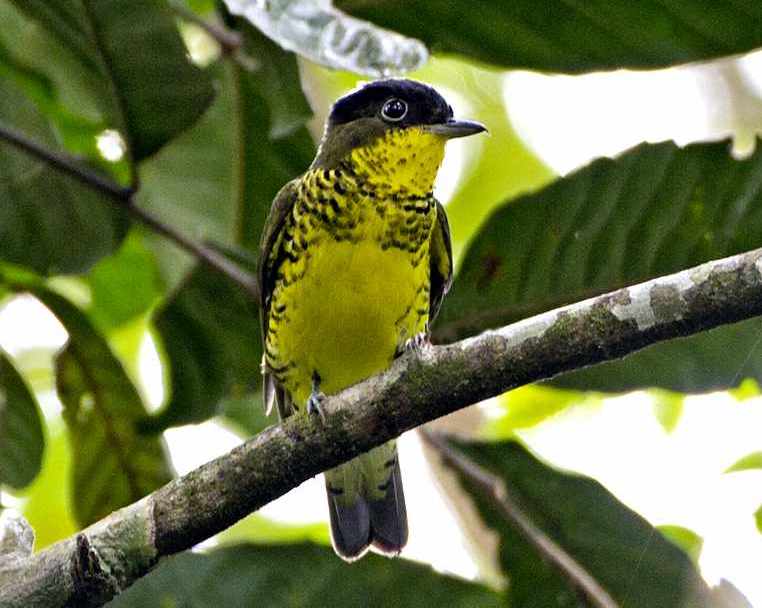
Adult Elegant Mourner, REGUA, 31st March 2012 Ciro Albano. Jon and Adilei - REGUAs superb local guide - repeatedly found this individual, and there were many tense minutes until Ciro, one of Brazils well-known bird photographers who was with us (and who had never previously seen the species) could get a photo. Elegant Mourner is highly sought-after by birders to South America. It is one of several species (Russet-winged Spadebill being another) that can be very tricky to find throughout their range, but, for reasons that remain unclear,are rather straightforward at REGUA.
The truck perched precariously in the only flat(ish) pullout on the extremely steep access road up Pico da Caledonia, with the city of Nova Friburgo far below to the right. REGUA proved to be a great base to visit the Pico da Caledonia, a 2200m peak (barely a hill in the Andes, but high for Brazil) famous among birders as the most accessible place to find Grey-winged Cotinga. There is only an access road because the top is covered in antennae, and apart from the occasional maintenance vehicle, it is virtually deserted on weekdays. Jon found Grey-winged Cotingas in the trees just to the right of the truck, among other places. Intending to stay just a night, the weather and birding were so pleasant that he stayed up there for three.
Grey-winged Cotinga, Pico da Caledonia, 19th April 2012. Not a good photo, but it was over 100m away. Despite occurring in the mountains just north of the city of Rio de Janeiro, this cryptic species was only described in 1980, and remains very poorly known. It has a tiny distribution and an estimated population of perhaps 1000 individuals. We had visited a week earlier with clients during a day trip from REGUA but missed the species. Jon quickly recognised why; he saw them every day, but almost exclusively in the hour before dusk, andagainfor an hour or so after dawn, times when they were much more vocal and obvious than expected. This was yet another example of the great advantage of being able to camp onsite. Jon was able to record several cotinga vocalisations including some that appear to have been previously unknown.
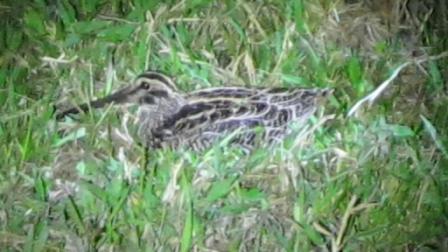
Videograb of Giant Snipe, near Matumbo, 7th April 2012. Although not especially rare throughout its fairly broad distribution, the largest of the snipe is only reliably found at a few sites, and some fields near REGUA happen to be one of those. More like a woodcock, they are only vocal at night, which makes them much easier to locate, when it is possible to spotlight them on the ground. To minimise disturbance, we would not visit with clients more than once per week, but each time we were able to locate one and get within a few metres.
South-east Brazil revisited
Posted 27 March 2012
South-east Brazil is one of the most important regions for endemic wildlife in the world, and Brazil contains more bird species classified as Critically Endangered than any other country in the World, many of them found in this area. Although we spent a month in southeastern Brazil back in 2006,we have easily managed to keep ourselves occupied second-time-around, and we have tracked down most of the species we missed or werent able to try for previously. We have visited many new sites on this trip and re-visited some of those that we particularly enjoyed on our previous trip.
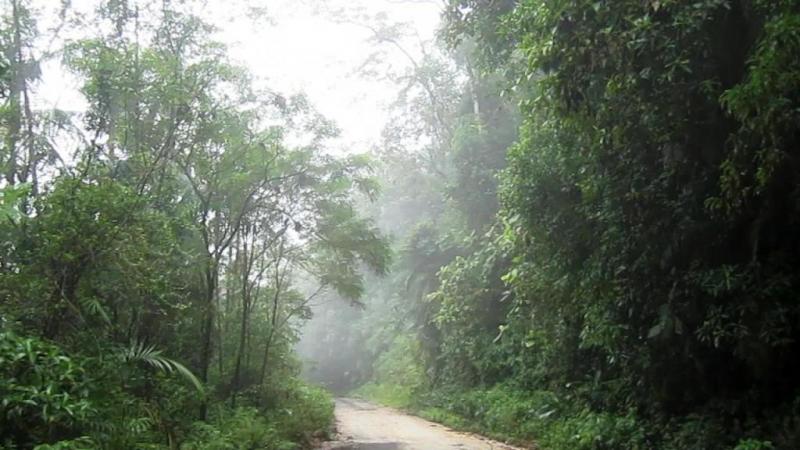
Perhaps our favourite new site was Parque Estadual Carlos Botelho, in So Paulo state, which we visited just after leaving our friends the Almeida family (see Fazenda Santo Antonio below). This is one of the most complete tracts of remaining Brazilian Atlantic rainforest (Mata Atlantica), and hence home to some superb wildlife. Located on the scarp where the planalto drops down to the coast, it is almost permanently misty and/or rainy, which of course helps produce such verdant forest. Our best bird here was Black-fronted Piping Guan, but this was almost overshadowed an hour later by a troop of 11 Muruqui monkeys, the largest and one of the rarest New World primates, which gave us a great show swinging through the trees as they crossed the one track that traverses the park.
One of the sites we re-visited was Parque Nacional Serra da Canastra. The photo above is of the Rio So Francisco, just downstream from its source in the plateau grasslands of the serra and immediately upstream of the spectacular Casca DAnta (below). If you look closely, you can just make out Jon standing in the lower left corner of the waterfall photo. Though not nearly as famous as the Amazon, the Rio So Francisco is one of the longest rivers in Brazil, snaking its way for over 2000 kilometres from its origin here in southeastern Minas Gerais state (inland of Rio de Janeiro) to the Atlantic Ocean along the border of the northeastern states of Sergipe and Alagoas. We will see this river again in a few months time far to the north.
Portions of the Rio So Francisco above and below Casca DAnta are home to one of the rarest ducks in the world: Brazilian Merganser (above). When we visited the park in 2006, we were very happy to find a pair just above the waterfall, and on this visit we were lucky to spot a pair several kilometers downstream of the waterfall.
One of our favorite mammal sightings ever was of this impressive Giant Anteater, well over two metres long, on the Serra da Canastra plateau. With their rather poor eyesight, we were able to get fairly close without disturbing it as long as we stayed downwind and enjoyed watching it meander its way through the grass for close to an hour.
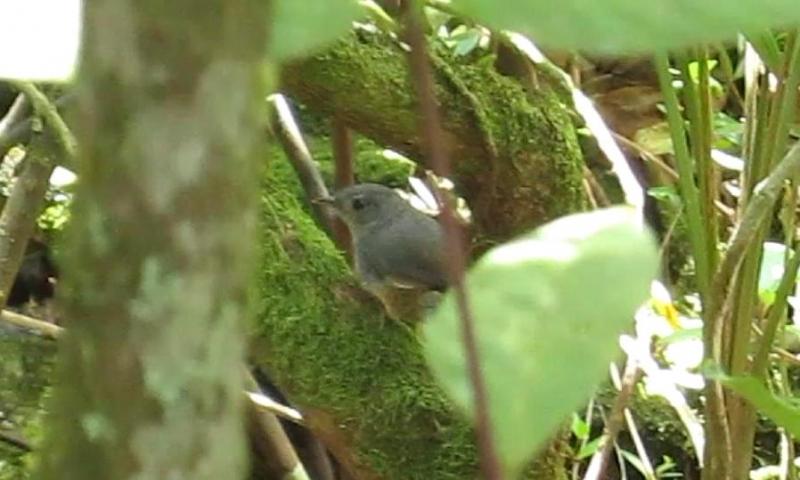
Regular readers may have noticed that Jon has a perverse weakness for seeing (and sound-recording) birds that are especially hard to see, with tapaculos featuring high on this list. With considerable effort, we have seen almost every species of this uniquely New World bird family on this journey. Extremely poorly known as a group, most species have never even had their nest found and described. Brasilia Tapaculo (above) was one of the birds we missed in 2006, and a major reason we returned to Serra da Canastra this time. In better weather than our earliervisit, one pair was very cooperative.
We will take whatever suitable campsite we can find, even in the yard of the "Congregation of Christ in Brazil"! It was late afternoon by the time we found our way to one of only a handful of sites for the very recently described So Paulo Antwren, and we had been unable to find a secure place to park near the marsh in question. Our only option was for Jon to politely ask the live-in caretaker woman if we could camp in the fenced churchyard. She was understandably perplexed by the request at first but then welcomed us warmly and even gave Anne a big bear hug upon our departure the next morning. (And yes, we did see the antwren, just across the road.)
Another new place we visited was Fazenda Caets in the state of Espirito Santo, one of only two known sites for Cherry-throated Tanager (Critically Endangered, of course). In 2006 we had decided not to try for this species, because access to the lone property where it was known was shockingly expensive. Since then, the species has been observed here at Fazenda Caets, so we decided to give it a try. In more than three days we had onlyone brief sighting of a tanager, but the birding throughout the forest was excellent, and we found a couple of our othermost-wanted species as well. The wonderful caretaker Paulo even allowed us to camp in the fazenda forest for three nights, which was so peaceful.
At least 85% of the Mata Atlantica has been cleared since European colonisation in the 1500s. This is the major reason for the large number of highly endangered animals in this region. Deforestation is especially severe northeast of Rio de Janeiro, so patches like Fazenda Caets are unusual and the species that rely upon it even more so. There is continuing pressure to make way for crops and tree plantations, as was evident in an area of the fazenda where the forest had been very recently cleared (above), right next to a GPS point where we know Cherry-throated Tanager was recorded about five years ago.
A new year, and two new countries (so far)
Posted 10 March 2012
Its hard to believe we have been in southern Brazil for almost two months. In early January we crossed into Uruguay, and after a couple of weeks there, carried on into southernmost Brazil. Although we spent a month in southeastern Brazil in 2006, we didnt visit the far south on that trip. So we took our time working our way north through this area, enjoying yet more lovely scenery and systematically tracking down the endemic birds restricted to this small region. There were also interesting cultural aspects to note, as this is the area in which a lot of European immigration was focused, particularly German. Apparently, there are towns in which 80% of the inhabitants can still speak German (we had one petrol pump attendant say auf wiedersehen to us as we drove away!). We also encountered evidence of Italian, Finnish, and Japanese influences. The latter became especially apparent as we moved into Sao Paulo state, which contains the largest population of people of Japanese descent outside Japan.
The Uruguayan parliament building in downtown Montevideo. We really enjoyed the relaxed atmosphere and lovely maritime climate of the Uruguayan capital. We stopped here for a few days ostensibly for Anne to get the visa necessary for Americans to enter Brazil, plus some servicing on our exceptionally hardworking truck. Among other more routine jobs, the windscreen needed to be replaced having been badly cracked in northern Argentina. We literally found the only F150 windscreen available in Uruguay, which was a big relief as our model of truck is not found in Argentina and Brazil, so this was the only chance to get it replaced in a one-year period!
Although the birding in Uruguay is overall relatively poor compared to other South American countries, there are some interesting areas, especially in the far east. One priority here was Saffron-cowled Blackbird, an endangered species that is rapidly declining throughout its small range. We had missed this species in eastern Argentina, where recent drought has added to the species problems. Fortunately we found them in a couple of areas in each of Uruguay and Brazil, and made an effort to systematically search for the species in these areas, gathering data for BirdLife International.
Typical habitat of Saffron-cowled Blackbird, Baados de San Miguel, eastern Uruguay. Occurring in small areas in the grasslands where Brazil, Paraguay, Uruguay and Argentina meet, available habitat for blackbirds has disappeared for many reasons, but in recent decades the planting of eucalypts (for wood and cellulose) and soya has especially fragmented the habitat. In the area shown in this photo we found a flock of 164 blackbirds, apparently the largest flock observed outside Paraguay in about a decade.
Another sought-after species. Black-and-white Monjita (this one a male). Generally quite scarce, although for reasons unknown to us it was easy to find in eastern Uruguay and southernmost Brazil in January 2012. They have an unusual relationship with Saffron-cowled Blackbird, often leading blackbird flocks around. While the monjitas clearly act as sentinels for the blackbirds, it is unclear what the monjitas get from the relationship. Searching for the much more obvious monjitas was often a good way to track down blackbirds (that were often hidden feeding in the grass).
Scarlet-headed Blackbird is a fairly widespread species in marshland in several countries in south-east South America, but seemed especially numerous locally in eastern Uruguay. Occasionally we saw them with Saffron-cowleds, which created quite a riot of colour.
We have simply seen too much spectacular scenery in the past couple of years. Anne takes a nap rather than continue to admire the canyons of Parque Nacional Serra Geral, situated on the border of Rio Grande do Sul and Santa Catarina states, southern Brazil. This was yet another of innumerable parks and reserves that have let us camp despite not allowing camping. Theres just no harm in asking. The remarkably friendly park guard, Jose, radioed HQ to get special permission for us to camp just inside the entry gate. This proved to be the best possible spot, right next to an excellent forest patch with most of our key species. The species we most wanted to see here, Striolated Tit-Spinetail, sang from a bush two metres from the back door of the camper while we were having tea our first afternoon!
Long-tailed Cinclodes, Serra do Faixal, Rio Grande do Sul, Brazil, 22 January 2012. One of the prize endemic birds of southernmost Brazil. Although the Atlantic rainforest of south-east Brazil is quite heavily visited by birdwatchers, the areas south of Sao Paulo are much less well known, but have plenty of special birds too.
With all the attention that the Amazon rightly receives, the habitat pictured above is not what first comes to mind when thinking of forest in Brazil. Relatively cool, damp Araucaria (monkey puzzle) dominated forest formerly covered much of southern Brazil and adjacent border areas of Paraguay, Uruguay and Argentina. Although the total area is now much reduced - technically it is more threatened than the Amazon rainforest -we were still impressed by large tracts in some of the southern states, especially Santa Catarina. Many birds and other wildlife are found only inthis forest type.
Dawn over a bush camping site near Sao Paulo. We camp in reserves and parks whenever possible for obvious reasons, but the distances in Brazil often make it impossible for us to get between sites in a day. Fortunately the largest South American countries have great networks of petrol stations with free facilities for truckers - water, showers, big spaces to park, even wifi internet sometimes - and we just muck in with them.
Fazenda Santo Antonio
Posted 19 February 2012
Although we have much to write about from our brief time in Uruguay and our first month in Brazil, we wanted to first do a different sort of posting. Three recurring features of the trip recently came together in one remarkable turn-of-events: serendipity, the friendliness of virtually everyone we have encountered, and the attention the vehicle attracts (the latter has been the case throughout our trip but is an order of magnitude greater in Brazil).
On our way to the well known (among birders) Parque Estadual Intervales in southern So Paulo state, we stopped at the nearby town of Capo Bonito to check email. Anne finished early and wandered back to the town plaza where we were parked. While she waited for Jon, a guy pulled in next to our truck at the only available parking space around the whole plaza. He had noticed the California license plates and immediately came over and asked Anne if she was American. He was excited by her answer as he and his wife had recently been to California. Despite extreme communication challenges (i.e., neither of them being able to speak much of the others language) Anne and her new friend, Hlio, persisted with a conversation. Within ten minutes, Hlio had invited us to his house. Even though Anne tried to graciously decline, he called his wife on the phone to warn her of our potential arrival and proceeded to wait with Anne for Jon to return. Jon also thanked him very much for the offer but tried to politely decline several times before we finally agreed to follow him home!
A few kms outside town, we arrived at a lovely fazenda (farm) where Hlio and Jaqueline live with their sons Hlio (Helinho) and Antonio, 20 and 16 years old, respectively. We were so enchanted by the exceptional welcome (and abundant homemade cheese!) that after tea and snacks and a tour of their soya farm, we agreed to stay for dinner and then to camp in their yard. We were joined at dinner by another lovely local family and treated to a delicious traditional meal of chicken and rice prepared by the two mothers. Conversation at dinner was made a bit easier by Fabiana, the daughter of the visiting family, as she spoke excellent English, having lived in Canada and Australia. Her brother Leandro spoke a fair bit too from his time competing in rodeos in the U.S. As we sat around enjoying dinner and conversation, being treated like family, it was a bit surreal to think that we had met Helio in the town plaza only a couple of hours before.
We had little option but to promise to return after birding at Intervales, and stayed two nights on our second visit at the fazenda. We had a wonderful time, including more lovely food and very enjoyable conversations despite our communication challenges. With Helinhos moderate Spanish, we were fairly easily able to get by with Sportuguese! A highlight was when Hlio and Jaqueline took us to the farming cooperative to which they belong. All of the people there were very welcoming and interested in what we are doing. Many of the members, including the director, are of Japanese heritage....not surprising given Sao Paulo has the largest population of people of Japanese descent outside Japan.
It wasnt easy to tear ourselves away, but we eventually had to move on. The generosity and kindness of Hlio and family was truly remarkable. Within an hour of meeting him, Antonio had given Jon a soccer jersey from his favorite team (Corinthians), and Jaqueline gave Anne a beautiful scarf as they parted. Hlio's engaging personality was evident in him almost instantly welcoming us to his home, and young Helinho had a unique warmth and skill in communicating that helped us feel especially comfortable. We learned a great deal of Portuguese very quickly, and much about Brazilian soya farming, a topic which we had recently been reading about. We plan to return to Fazenda Santo Antonio in the future......
Anne in front of Fazenda Santo Antonio, with Antonio and Jaqueline on the left and the two Helios on the right (plus Pandora the dog).
View of the 240ha of soybean fields (and Helinho) during our drive aroundthe fazenda.
Dinner the first night with our new friends. Unfortunately, Fabiana is behind the camera, but her brother Leandro and their parents are on the left with Jon, Helio and Jaqueline at the head of the table, and Anne with sons Antonio and Helio on the right.
Jon trying his hand at milking the family cow (which provided all the milk, and hence cheese, for the fazenda). If you look closely, you can see he was actually pretty effectivedespite beinga rookie.
Image copyright notice
All images on this website are subject to copyright (© Jon King, unless otherwise stated). If you wish to use them, whether commercially or non-commercially, please inform Jon by email.
Images appearing on calyptura.com can be used free of charge by individuals and non-profit organisations for strictly non-commercial use. They can be linked or copied to other websites, or downloaded to personal computers. The only exception to this policy concerns non-commercial use of images by any individual or organisation promoting trade in captive birds, or any other activity deemed detrimental to wild birds and their habitats. This use is not permitted.
All other commercial use of images is unauthorized. If you would like to use images for any commercial purpose (i.e. publication in books, magazines, commercial websites, advertisements etc.), or if you are seeking higher resolution scans, slide duplicates or prints, please contact Jon by email.
Jon and Anne's birding travels
